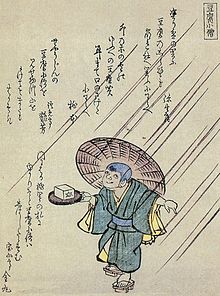
Just like the human world, the realm of yokai have a status hierarchy system. The strong and powerful sits at the top of the food chain. Of course, these yokai are able to cause misery and chaos nationwide. For example, the legendary Yamata-no-Orochi who can bring earthquakes and floods on a whim. On the other hand, there are low-class yokai at the very bottom of the pyramid. They serve and attends to other yokai. Moreover, some are also subservient to humans. Today, we study one of these feeble yokai. We present to you tōfukozō the original vegan of Edo.

Tōfukozō is well-known all across Japan. Although, they may not be as popular as kappa and tanuki. But, tōfukozō is the definitely the most well-liked yokai. They are mild-mannered and gracious to the humans they meet. In fact, they are frequently featured in kaidan story compilations and kibyōshi picture books of the Edo period.
Appearance
Tōfukozō is often depicted as a yound boy carrying a plate of tofu. A yokai boy who brings protein rich food to their masters. Also, he wears gaudy clothes printed with auspicious patterns. As such, encounters with tōfukozō bring good luck and ward diseases away.
Interestingly, tōfukozō delivers a unique tofu known momiji-dofu. It is a specialty of Sakai City (堺市), Izumi province. The tofu has the autumn maple leaf imprinted on it. Evidently, the tofu brings good health and luck for those who eat them.
Although tōfukozō are often seen human-like, some have depicted them with monster features. For example, some have one large eye instead of the usual, and more comforting, two. Sometimes, tōfukozō walk bare-footed with two-clawed feet. Nonetheless, they always carry their precious tofu and offering them to strangers. Tōfukozō is the original vegan of Edo.
Conclusion
Although tōfukozō is depicted as a servant-type yokai, little else is known. Legends say that the momiji-dofu regenegates one’s health and spiritual enegery. In contrast, some believe that the tofu was once human. Now cursed to be fed to tōfukozō‘s master. While others surmised, it was a ploy to promote eating tofu when meat proteins were scarce. Whatever it maybe, we may never know. But if you do happen to meet tōfukozō, accept their tofu graciously. Share your food. Or else, you will be cursed into a tofu!
Yokai Details
- name: tōfukozō ( toh-foo-koh-zoh )
- kanji: 豆腐小僧 (とうふこぞう)
- meaning: tofu boy
- abilities:
- tofu manipulation — able to create, shape and manipulate any type of tofu
- tofu animation — power to bestow some sentience to tofu


